Sanyo VPC-C5BLGX, VPC-C5BLE, VPC-C5BL, VPC-C5BLEX Manual
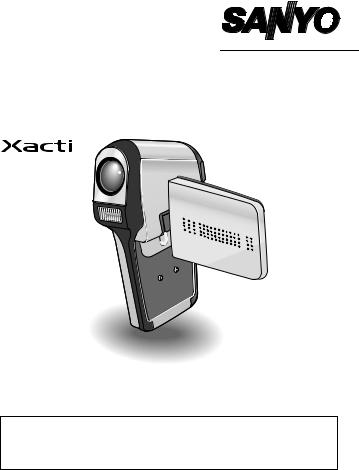
INSTRUCTION MANUAL
Digital Movie Camera
VPC-C5EX VPC-C5E VPC-C5
VPC-C5GX
Important note
This manual explains how to safely operate the VPC-C5EX, VPC-C5E, VPC-C5, and VPC-C5GX.
Any information regarding only one of these products will be labeled as such.
Please read these instructions carefully before using the camera. Make sure to read and understand the section “USING YOUR CAMERA SAFELY AND CORRECTLY” on pages 7 to 20. Keep this manual in a safe place for later reference.

Warning
TO PREVENT THE RISK OF FIRE OR ELECTRIC SHOCK, DO NOT EXPOSE THIS APPLIANCE TO RAIN OR MOISTURE
FOR AMERICAN USERS
WARNING:
This product contains chemicals, including lead, known to the State of California to cause cancer, and birth defects or other reproductive harm.
Wash hands after handling.
i This equipment has been tested and found to comply with the limits for a Class B digital device, pursuant to Part 15 of the FCC Rules. These limits are designed to provide reasonable protection against harmful interference in a residential installation. This equipment generates, uses and can radiate radio frequency energy and, if not installed and used in accordance with the instructions, may cause harmful interference to radio communications. However, there is no guarantee that interference will not occur in a particular installation. If this equipment does cause harmful interference to radio or television reception, which can be determined by turning the equipment off and on, the user is encouraged to try to correct the interference by one or more of the following measures:
h Reorient or relocate the receiving antenna.
h Increase the separation between the equipment and receiver.
hConnect the equipment into an outlet on a circuit different from that to which the receiver is connected.
h Consult the dealer or an experienced radio/TV technician for help.
iChanges or modifications not expressly approved by the party responsible for compliance could void the user’s authority to operate the equipment.
Declaration of Conformity
Model number: VPC-C5 Trade Name: SANYO
Responsible party: SANYO FISHER COMPANY
Address: 21605 Plummer Street, Chatsworth, California 91311 Telephone No.: (818) 998-7322
This device complies with Part 15 of the FCC Rules. Operation is subject to the following two conditions:
(1)this device may not cause harmful interference, and
(2)this device must accept any interference received, including interference that may cause undesired operation.
iEnglish
FOR CANADIAN USERS
i This Class B digital apparatus complies with Canadian ICES-003.
English ii
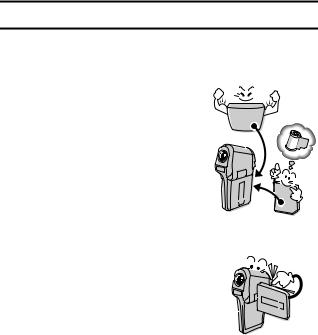
OUTLINE OF OPERATION
To help you get started enjoying using your camera right away, given below is an outline of the basic operation, from setup to shooting to playback.
SETUP
1 Charge the battery pack (page 35).
2 Install the battery pack (page 37).
3 Install the SD Memory Card* (page 38).
4 Format the SD Memory Card (page 134).
CAUTION
i This camera uses an SD Memory Card instead of photographic film to record images. Be sure to install the SD Memory Card before operating the camera.
i Be sure to format the SD Memory Card with this camera before using it. A card that is not formatted using the camera may limit your full use of all the camera’s capabilities.
SHOOTING
1 Turn on the camera (page 40).
2 Capture images.
h For shooting video clips, see page 47. h For shooting still photos, see page 49.
Please see the section “HINTS FOR TAKING PICTURES” at the end of this manual
(page 187). This section provides additional information to help you get the most out of your camera.
1 English

PLAYBACK
1 Play back the images (page 55).
* About the SD Memory Card
In this manual, the SD Memory Card is referred to as “card”.
Symbols used in this manual
HINT Points that may prove useful when using the camera.
NOTE Points giving some extended instructions or special points to pay attention to.
CAUTION Points that require special attention.
(page xx) Refer to the page indicated for detailed information.
You may find the answers to questions or problems concerning camera operation in the sections “COMMONLY ASKED QUESTIONS” (page 160) and “TROUBLESHOOTING” (page 167).
English 2

CONTENTS |
|
OUTLINE OF OPERATION ................................................................... |
1 |
USING YOUR CAMERA SAFELY AND CORRECTLY ......................... |
7 |
FOR CORRECT USE OF YOUR CAMERA ......................................... |
21 |
CHECKING THE INCLUDED ACCESSORIES .................................... |
25 |
GETTING THE MOST OUT OF YOUR CAMERA ............................... |
29 |
PREPARATION |
|
PARTS NAMES ................................................................................... |
32 |
CHARGING THE BATTERY PACK ..................................................... |
35 |
INSTALLING THE BATTERY PACK AND CARD ................................ |
37 |
TURNING THE CAMERA ON AND OFF ............................................. |
40 |
OPERATION BUTTONS ...................................................................... |
42 |
BASIC OPERATION |
|
SHOOTING/RECORDING |
|
BEFORE TAKING PICTURES ............................................................. |
44 |
CAPTURING IMAGES ......................................................................... |
47 |
BASIC SHOOTING FUNCTIONS ........................................................ |
51 |
RECORDING AN AUDIO MEMO ......................................................... |
53 |
PLAYBACK |
|
VIEWING IMAGES .............................................................................. |
55 |
VIEWING VIDEO CLIPS ...................................................................... |
58 |
PLAYING BACK AUDIO MEMOS ........................................................ |
60 |
3 English
SHOOTING SETTINGS |
|
PAGE 1 (BASIC SETTINGS) |
|
DISPLAYING THE SHOOTING SETTING SCREENS ......................... |
61 |
IMAGE QUALITY .................................................................................. |
67 |
SCENE SELECT .................................................................................. |
69 |
FILTERS ............................................................................................... |
71 |
FLASH SETTING .................................................................................. |
72 |
SELF-TIMER ........................................................................................ |
74 |
PAGE 2 (ADVANCED SETTINGS) |
|
MOTION COMPENSATION (IMAGE STABILIZER) ............................. |
76 |
FOCUS RANGE ................................................................................... |
78 |
FOCUS AREA SETTING ...................................................................... |
80 |
LIGHT-MEASURING MODE SETTING ................................................ |
81 |
ISO SENSITIVITY ................................................................................. |
82 |
WHITE BALANCE ................................................................................ |
83 |
PLAYBACK SETTINGS |
|
PAGE 1 (BASIC SETTINGS) |
|
DISPLAYING THE PLAYBACK SETTING SCREENS ......................... |
85 |
PLAYBACK MODE ............................................................................... |
89 |
VOLUME ............................................................................................... |
90 |
LCD MONITOR BRIGHTNESS ............................................................ |
91 |
IMAGE PROTECT ................................................................................ |
92 |
ERASING DATA ................................................................................... |
94 |
PAGE 2 (ADVANCED SETTINGS) |
|
ROTATE IMAGE ................................................................................... |
96 |
EDITING VIDEO CLIPS ........................................................................ |
97 |
PRINT SETTINGS .............................................................................. |
105 |
DISPLAYING IMAGE DATA (INFORMATION SCREEN) .................. |
112 |
English 4
CAMERA SETTINGS |
|
OPTION SETTINGS |
|
DISPLAYING THE OPTION SCREEN ............................................... |
113 |
DATE AND TIME ............................................................................... |
115 |
OPERATION SOUNDS ..................................................................... |
118 |
HELP DISPLAY ................................................................................. |
120 |
POST-VIEW SETTING ...................................................................... |
121 |
WIND NOISE REDUCTION ............................................................... |
122 |
NOISE-REDUCTION ......................................................................... |
123 |
FLICKER-REDUCTION ..................................................................... |
124 |
DIGITAL ZOOM SETTING ................................................................. |
125 |
SCREEN LANGUAGE ....................................................................... |
126 |
TV OUTPUT SETTING ...................................................................... |
127 |
POWER SAVE FUNCTION ............................................................... |
129 |
FILE NO. RESET FUNCTION ............................................................ |
131 |
FORMATTING A CARD ..................................................................... |
134 |
RESETTING THE CAMERA SETTINGS ........................................... |
136 |
CHECKING THE REMAINING CARD MEMORY .............................. |
137 |
CHECKING THE REMAINING BATTERY PACK CHARGE .............. |
139 |
5 English
OTHER DEVICES AND CONNECTIONS |
|
DOCKING STATION |
|
CONNECT THE DOCKING STATION ............................................... |
141 |
SET THE CAMERA IN THE DOCKING STATION ............................. |
142 |
CONNECTING TO OTHER EQUIPMENT .......................................... |
143 |
PREPARING AND USING THE REMOTE CONTROL UNIT ............. |
145 |
PLAYBACK WITH THE DOCKING STATION .................................... |
149 |
DIRECT PRINTING ............................................................................ |
150 |
CABLE ADAPTOR |
|
CONNECTIONS ................................................................................. |
159 |
APPENDICES |
|
COMMONLY ASKED QUESTIONS ................................................... |
160 |
TROUBLESHOOTING ........................................................................ |
167 |
SPECIFICATIONS .............................................................................. |
179 |
HINTS FOR TAKING PICTURES ....................................................... |
187 |
English 6
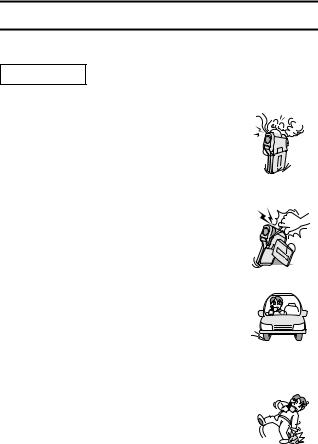
USING YOUR CAMERA SAFELY AND CORRECTLY
CAMERA
WARNING
k If the camera makes a strange noise, emits a strange odor, or if smoke comes out from it, immediately turn off the power and remove the battery pack
i If the camera is used under these conditions, it may cause a fire or electric shock. Immediately turn off the camera, remove the battery pack, and wait to make sure no more smoke comes from the camera. Then take it to the dealer for service. Do not try to repair or open the camera yourself.
kDo not modify or open the cabinet
i High voltage circuits are inside, and there is a high risk
of fire or electric shock if they are touched. Any internal check, setting, or repair should be performed by the dealer.
kDo not use while driving
i Do not capture images, play back images, or watch
the LCD monitor while driving a vehicle. Doing so may cause an accident.
i Be careful where you put down the camera inside an automobile. During sudden stops or turns it may fall behind the brake pedal and prevent braking.
kBe aware of your surroundings when using the camera
iPay close attention to your surroundings when using the
camera. Failure to do so may lead to an accident or injury.
i When using the camera while walking, be very careful of your surroundings and especially the traffic to avoid accidents.
i Do not use the camera inside an airplane or elsewhere where its use may be restricted.
7 English
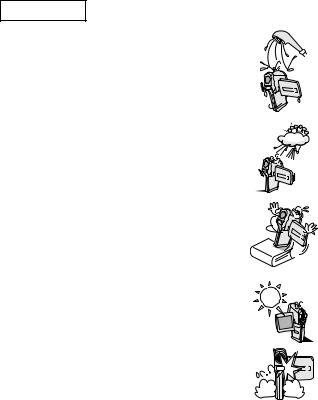
WARNING
kDo not get the camera wet
i This camera is not water-resistant. Do not allow it to get
wet, as doing so may cause a fire or electric shock. i Do not use the camera in a bathroom.
i If the camera gets wet, immediately turn it off and remove the battery pack. Then take it to a dealer for repair. Using the camera after it has been become wet may cause a fire, electric shock, or other accident.
kDo not use during a storm
iTo avoid the risk of being struck by lightning, do not use the camera during a thunderstorm. In particular, if used in an open field, you have an increased chance of being struck by lightning. Quickly seek refuge in a place that will protect you from lightning.
k Do not place on an unstable surface
i The camera may fall, resulting in damage to the camera or injury.
i If the camera has fallen and its body is damaged, turn it off, remove the battery pack, and take it to the dealer for repair. Using the camera after its body has been damaged may cause a fire or electric shock.
kDo not look through the camera into the sun
iDo not look through the camera at the sun or any other strong source of light. Doing so may seriously injure your eyes.
k Do not use the flash close to a person’s face
i To prevent possible eye injury, do not use the flash near a person’s face (especially young children or babies). If the flash is used close to a person’s opened eyes, there is a risk that it may damage that person’s eyesight.
English 8

USING YOUR CAMERA SAFELY AND CORRECTLY
WARNING
kDo not use where there is risk of explosion
i Do not use the camera in a location where there is
explosive gas, or any other flammable material in the air. Doing so may cause a fire or an explosion.
kKeep the camera out of the reach of children i The following may happen if children play with the
camera:
h They may wrap the neckstrap around their neck and suffocate.
h They may swallow the battery pack or other small parts. In such a case, consult a physician immediately.
h They may damage their eyesight if the flash goes off too close to their eyes.
h They may get hurt by the camera.
CAUTION
kCautions when carrying the camera
i Do not walk around with the camera suspended from
your neck. It may hit other objects and get damaged. When walking around, hold the camera in your hand or place it in a pocket.
i Be careful not to drop the camera or subject it to strong shocks.
i Make sure direct sunlight does not hit the camera lens, as that may damage the internal parts. When not using the camera, be sure to always turn it off and close the lens cover.
k If the camera is not going to be used for a long period of time
i For safety’s sake, remove the battery pack from the camera. This will prevent any possible excess heat or leakage of battery fluid that may result in injuries or damage to nearby objects. (Note that when the battery pack is removed for a long period, the time and date settings will be cleared.)
9 English

CAUTION
kCautions during use and storage
i This camera is a precision instrument. When using or
storing the camera, make sure to avoid the following locations to avoid damage.
h Places in direct sunlight
h Places where humidity and temperature are high h Places that may get wet
h Places close to an air conditioner or heater h Inside a car
h Places where there is dust and dirt h Places where there is a fire burning
h Places where volatile products are stored h Places subject to vibration
Operating environment: |
|
h Temperature |
0 to 40°C (32 to 104°F) (operation) |
|
–20 to 60°C (–4 to 140°F) (storage) |
h Humidity |
30 to 90% (operation, no condensation) |
|
10 to 90% (storage, no condensation) |
|
|
English 10

USING YOUR CAMERA SAFELY AND CORRECTLY
DOCKING STATION AND AC ADAPTOR/CHARGER
DANGER
k Do not recharge battery packs that are not Li-ion battery packs (Model DB-L20)
i Do not recharge a battery pack other than the supplied Li-ion battery pack (DB-L20). Recharging a dry-cell battery or other type of rechargeable battery may cause excess heat, combustion, or leakage, and cause a fire, injuries, burns, or damage to nearby objects.
k Concerning the power cord
i The voltage rating for the power cord supplied with this camera conforms to the standards of the country in which the camera was sold.
k Do not disassemble or modify
i It is dangerous to touch the inside. Doing so may cause a fire or electric shock.
i Do not use as a direct current generator.
kDo not get the docking station or AC adaptor/ charger wet
iMake sure they do not get wet, as doing so may cause
a fire or electric shock.
i Do not use the camera in a bathroom.
i If the docking station or AC adaptor/charger gets wet, immediately unplug it from the power outlet and remove the battery pack. Then contact the place of purchase. If used while wet, it may cause a fire, electric shock, or an accident.
11 English
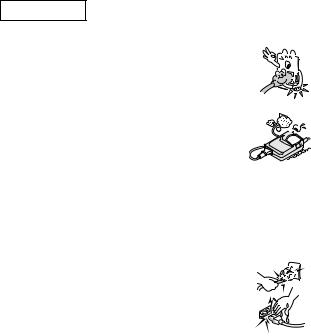
DANGER
kCautions when plugging in
i Securely plug the power cord all the way into the
power outlet. If the docking station or AC adaptor/ charger is used with the power cord not fully plugged in, heat may be generated and cause a fire.
i Do not use if the power cord is damaged or cannot be correctly plugged into the power outlet. Using in this condition may cause a fire or electric shock.
i Do not allow dust, etc., to build up on the power cord or power outlet. A build-up of dust may cause a short circuit or generate heat and cause a fire.
i When unplugging the power cord, be sure to hold the plug part and slowly pull it out of the power outlet. Pulling the cord portion may damage the power cord and cause a fire or electric shock.
k Do not pull on the power cord to unplug it
i Do not leave the power cord plugged into an electrical outlet while the other end is not plugged into the AC adaptor/charger. The loose end can cause electrocution if touched with wet hands or if handled by children.
i Use only the supplied power cord. If a different power cord is used, it may be rated for a different current load, and that may cause a fire.
i The supplied power cord is for exclusive use with the devices supplied with your camera. Do not use it with other devices, as doing so may cause a fire or electric shock.
i Do not use a bundled power cord, as the heat generated may cause a fire.
i When using an extension cord, make sure that the total wattage of the connected devices does not exceed the rated value of the extension cord. If the power load exceeds the rated value, it may cause a fire.
English 12
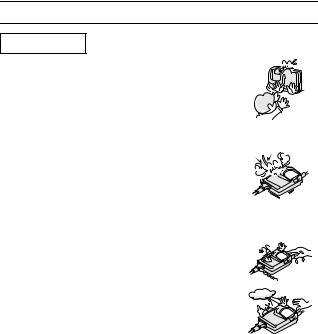
USING YOUR CAMERA SAFELY AND CORRECTLY
DANGER
k Keep out of the reach of children
i Children may place the battery pack or other small components in their mouth or perform some other such unforeseeable action. If swallowed, consult a physician immediately.
kIf smoke or a strange odor is emitted, or if strange noises are heard, immediately unplug the power
cord from the power outlet
i If used under these conditions, it makes cause a fire or electric shock.
i If strange conditions such as these occur, immediately unplug the device, remove the battery pack, and wait to make sure no more smoke is emitted. Then contact the place of purchase. Do not try to repair or open the device yourself.
k Do not handle with wet hands
i Handling the docking station or AC adaptor/charger with wet hands may cause an electric shock.
k Do not use during a storm
i Do not touch the docking station, AC adaptor/charger or power cord while it is plugged into a power outlet during a thunderstorm. Doing so may cause an electric shock.
13 English
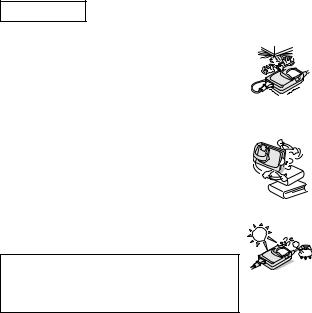
CAUTION
kDo not damage the power cord
iDo not place heavy objects on the power cord. Do not place the power cord near a heat source. Do not excessively bend the power cord, modify it, or secure it with staples. Doing so may damage the power cord
and cause a fire or electric shock.
i If the power cord is damaged, or if it does not plug properly into the docking station, AC adaptor/charger or wall outlet, contact the place of purchase.
k Do not place on an unstable surface
i The camera may fall, resulting in damage to the camera or injury.
i If it falls and the body is damaged, remove the battery pack and contact the place of purchase. If used while damaged, it may cause a fire, electric shock, or other damage.
k Operating and storage conditions
i Do not use close to a heat source (close to a stove or heater) or leave it exposed to direct sunlight.
Operating environment:
h Temperature |
0 to 40°C (32 to 104°F) (charging) |
|
–20 to 60°C (–4 to 140°F) (storage) |
h Humidity |
20 to 80% (charging and storage) |
English 14
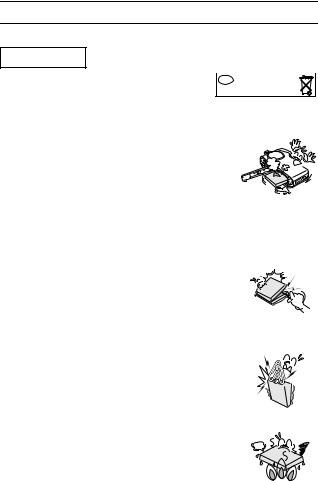
USING YOUR CAMERA SAFELY AND CORRECTLY
Li-ion BATTERY PACK (DB-L20)
DANGER
This camera uses a Li-ion battery pack (Model |
|
|
|
NL |
Batterij niet |
||
DB-L20). |
|||
|
weggooien, maar |
||
|
|
inleveren als KCA. |
kIf there is leaking, discoloration, change
of shape, rise in temperature, damaged exterior, strange odor or any other abnormal condition, immediately discontinue use and remove the
battery pack from the camera, taking care to keep it well away from fire
i Continued use of the battery pack under any of these conditions may result in fire, injury, explosion or other serious damage.
i If battery fluid is leaking, placing the battery pack in close proximity to a fire or other heat source may ignite the battery fluid and result in fire, damage, eruption of battery fluid, or smoke fumes.
kDo not transform, take apart, or modify
i Safety mechanisms and protective devices have been
in incorporation in the battery pack for the purpose of preventing danger. Any modification, by transforming, disassembling, or directly soldering to it, etc., will defeat these safety devices and possibly cause the battery pack to catch fire, explode, or leak or spew battery fluid.
k Do not connect the (+) and (–) terminals with a wire or other metal implement. Do not carry loose or keep with necklaces, hairpins, etc.
i Doing so may result in a short circuit, high voltage flow, fire, explosion, leaking or spewing battery fluid, or heat generation. Metal such as a wire or necklace, etc. may cause heat to be generated.
k Do not throw the battery pack in the fire or subject it to heat
i Doing so may cause the insulation to melt, damage the gas discharge valve and safety mechanisms, or ignite the battery fluid, resulting in fire or explosion.
15 English

DANGER
k Do not drop, hit, or submit the battery pack to strong shocks
i If the safety mechanisms and protective devices are broken, an abnormal chemical reaction may occur inside the battery pack, or cause the battery pack to catch fire, explode, leak or spew battery fluid, or generate heat.
kDo not allow the battery pack to come into contact with fresh or salt water, or allow the terminals to
become wet
i If the safety mechanisms and protective devices are damaged by corrosion, an abnormal chemical reaction may occur inside the battery pack, or cause the battery pack to catch fire, explode, leak or spew battery fluid, or generate heat.
k Operating and storage conditions
i Temperature when using or recharging: 0 to 40°C (32 to 104°F)
i Do not use, recharge, store or leave the battery pack near fire or inside a car exposed to the hot sun, etc. (locations in which the temperature reaches 60°C [140°F] or higher).
i At high temperatures, the safety mechanisms and protective devices inside the battery pack may be damaged by corrosion, causing an abnormal chemical reaction to occur, or cause the battery pack to catch fire, explode, leak or spew battery fluid, or generate heat. If the safety mechanisms and protective devices are damaged, the battery pack will become unusable. An environment with extremely high or low temperatures will cause the battery capacity to deteriorate and shorten the usable time, and may even shorten the battery life.
i Avoid storing the battery pack with it near full charge. It is recommended to store the battery pack when it is near fully discharged.
i If the battery pack is completely discharged, it may become unable to be recharged again. To avoid this, charge the battery pack for at least five minutes every six months.
i Storage temperature: –10 to 30°C (14 to 86°F)
When not using the battery pack, remove it from the camera and store at –10 to 30°C (14 to 86°F) in a place with no condensation.
i Humidity: 10% to 90% (no condensation)
English 16
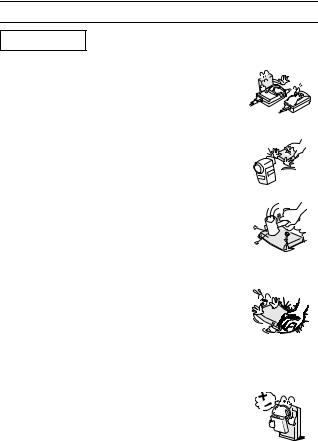
USING YOUR CAMERA SAFELY AND CORRECTLY
DANGER
kUse only the supplied docking station and AC adaptor/charger
i If another charger is used, the battery pack may be overcharged, or recharged with an abnormal voltage, causing an abnormal chemical reaction to occur, or cause the battery pack to catch fire, explode, leak or spew battery fluid, or generate heat.
k Use the battery pack only in the specified device i If the battery pack is used in a device other than that specified, it may cause an abnormal voltage flow, or cause the battery pack to catch fire, explode, leak or
spew battery fluid, or generate heat.
kDo not peel or damage the outer case
i Damaging the outer case, inserting nails, hitting with a
hammer, stepping on the battery pack, etc. may cause a short circuit inside the battery pack or cause the battery pack to catch fire, explode, leak or spew battery fluid, or generate heat.
kIf the battery pack is leaking and the electrolyte gets on your skin or clothing, immediately rinse
with clean water
i If the electrolyte gets into your eyes, you risk losing your eyesight. Immediately rinse your eyes with clean, running water, and seek medical attention right away. Any electrolyte that comes into contact with your skin or clothing may harm your skin. Immediately rinse the area with clean, running water.
k Insert the battery pack correctly, as specified i When installing the battery pack in the charger or
camera, pay attention to the indicated polarity (+ and –), and insert it correctly.
i If the battery pack is installed with the wrong orientation, it may cause an abnormal chemical reaction while in the charger, an abnormal voltage flow when it is used, or cause the battery pack to catch fire, explode, leak or spew battery fluid, or generate heat.
17 English
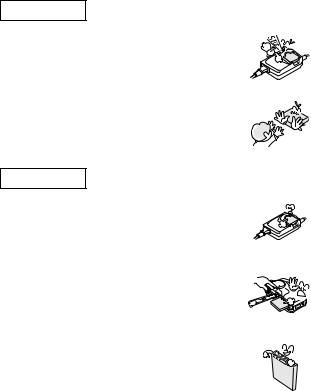
WARNING
k Always stop the recharging after the prescribed recharge time, even if the battery pack is not fully charged
i If you continue to recharge the battery pack, it may cause the battery pack to catch fire, explode, leak or spew battery fluid, or generate heat.
kKeep out of the reach of children
iThey may handle the battery pack in an unforeseeable manner that results in damage.
CAUTION
k Charge the battery pack before using it
i Always recharge the battery pack before using it for the first time, or when using it after it has been kept in storage for a long time. During recharging, the battery pack may be warm. This is normal and does not indicate a malfunction.
k Note concerning the battery pack after use
i The battery pack may be warm immediately after the camera is used. If removing the battery pack, turn off the camera and allow the battery pack to cool down before removing it.
k Recycling the battery pack
i To conserve the environment and for efficient use of natural resources, please discharge the used battery pack, cover the (+) and (–) terminals with tape and recycle the insulated battery pack.
i If disposing of the battery pack as unburnable trash, please follow all applicable regulations of your area.
English 18

USING YOUR CAMERA SAFELY AND CORRECTLY
CONCERNING THE ACCESSORIES
WARNING
kCautions concerning the use of the AC adaptor/charger
i Use only the supplied docking station and AC adaptor/charger with your
camera. Do not use a docking station or AC adaptor/charger other than the ones indicated here, designed for specific use with your camera.
i If a docking station or AC adaptor/charger other than the ones specified is used, it may damage the camera and cause a fire or electric shock.
i If the docking station or AC adaptor/charger is used in close proximity to a radio or TV set, it may cause interference with AM broadcast signals, resulting in noise. In this case, increase the distance between the radio or TV and the camera accessory.
kCautions concerning the card
iImmediately after use, the card will be very hot. Before removing the card, turn off the camera and wait for the temperature to cool down.
i Keep out of the reach of children. Young children may put the media in their mouth and choke or cause some other unexpected injury or accident.
19 English

CONCERNING THE LITHIUM BATTERY (CR2025)
WARNING
k Cautions concerning the CR2025 battery
i A CR2025 lithium battery is used for the remote control unit. Do not use a battery
other than the CR2025 lithium battery.
i Install the battery with the (+) and (–) terminals correctly oriented as indicated. If the battery is placed in the wrong orientation, it may cause a fire, overheating,
or rupturing. i Do not recharge, short circuit, disassemble,
modify, heat, or place the battery in a fire.
Doing so may cause a fire, overheating, or rupturing.
i Do not hold the battery with metal tweezers or a similar tool. Doing so may cause a short circuit leading to a fire, overheating, or rupturing.
i Do not perform soldering on the battery or use, store, or leave it near a fire, under direct sunlight, in a hot car, or other high temperature location.
i Do not use the battery if it is leaking.
i If the electrolyte gets into your eyes, you risk losing your eyesight. Do not rub your eyes, wash them immediately with clean water, and seek medical attention right away. If electrolyte gets on your skin or clothing, it may cause irritation. Immediately wash with clean water.
i Keep the battery out of the reach of children. If the battery is accidentally swallowed, contact a physician immediately. It may cause poisoning or suffocation.
i When disposing of batteries, make sure to follow all applicable regulations. i When disposing of the lithium battery, place tape on its positive (+) and
negative (–) terminals to prevent shorting. Do not mix the lithium battery with other batteries. Doing so may cause a fire or rupturing.
English 20

FOR CORRECT USE OF YOUR CAMERA
kCautions before capturing important images
iBefore capturing important images, make sure that the camera is operating properly and in condition to capture the image properly.
i Sanyo Electric shall not be held responsible for any losses that result from images that could not be recorded, are erased, destroyed, or damaged in any way due to a problem with the camera, any of its accessories, or its software.
k Caution concerning copyrights
i The images you capture with your camera are for your own private use; any other use may violate the rights of copyrights owners.
i Please note that photography may be restricted at stage performances, shows or exhibitions, even in presentations whose purpose is entertaining or amusing individuals.
i Also note that images that are intended to be copyrighted cannot be used outside those limits defined by the regulations of the relevant copyright laws.
k Cautions when cleaning the camera
Cleaning procedure
1 Turn off the camera and remove the battery pack. 2 Remove the dirt with a soft cloth.
If the camera is extremely dirty,
3Wipe with a soft cloth moistened with a mild detergent diluted with water and wrung dry.
CAUTION
i Do not use benzene or thinner products to clean the camera. Doing so may cause deformation, discoloration, or paint peeling. When using a chemically treated cloth, carefully read its instructions and warnings.
i Do not spray insecticides or volatile sprays on the camera. Do not let rubber or vinyl objects contact the camera for a long period. They may cause deformation, discoloration, or paint peeling.
21 English
k Caution concerning the battery pack
i Periodically clean with a dry cloth the terminals (contacts) of the battery pack. Do not touch the battery terminals with your bare hands. Doing so will allow contaminants from your hands to adhere to the terminals and oxidize, increasing the contact resistance. If the contact resistance increases, the usable life of the batteries will diminish.
kCaution when cleaning the lens
iIf the lens gets dirty, use a commercially available air blower or a cleaning cloth for photographic equipment to clean it.
k When not using the camera for a long period
i Remove the battery pack. However, when the battery pack is removed for a long time, the camera functions may begin to not work properly. Periodically reinstall the battery pack and check the camera functions.
i If the battery pack is left in the camera, a small amount of power is still used even if the camera is turned off. If the battery pack is left in the camera for a long period, it may become completely discharged and lose its ability to be recharged again.
kCautions concerning condensation
i Using the camera with condensation inside it may damage the camera.
If condensation seems likely to form
i Place the camera in a plastic bag and seal it, and then wait until the camera has reached the ambient temperature.
Be careful of condensation under the following conditions
i When moving the camera suddenly from a cold place to a warm place.
i When the ambient temperature changes drastically, such as when a heater is turned on to quickly heat the room.
i When the camera is placed in the path of cool air from an air conditioner. i When the camera is placed in a location of high humidity.
English 22
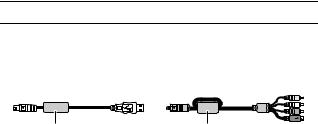
FOR CORRECT USE OF YOUR CAMERA
k Caution concerning undesired interference
i The camera may create undesired interference if used close to a television or radio. To avoid this type of interference, make sure the cores on the supplied cables are not removed.
Dedicated USB interface cable |
Dedicated S-AV interface cable |
Core |
Core |
k Caution concerning magnetism
i Do not place credit cards, bank cards, floppy disks, or other items that may be damaged by magnetic fields near the speaker. Data may be lost or the magnetic strips on cards may be damaged.
kCautions concerning data storage
i It is recommended that any important data be copied onto a separate
media (such as a hard disk, MO disk, or CD-R disk).
i Stored data may be lost (or corrupted) in cases such as those listed below. Sanyo Electric will not be held responsible for any damage or lost profits arising from the loss of data.
h If the card is used incorrectly.
h If the card is not inserted correctly into the camera.
hIf the card is subjected to electrical or mechanical shocks or other forces.
h If the card is removed from the camera or if the camera is turned off during reading or writing operations.
h If the card has reached the end of its usable life.
23 English
kCautions when handling the cards
i The cards are precision devices. Do not bend, drop, or subject them to
strong forces or shocks.
i Avoid using or storing the cards in places with extremely high or low temperatures, subject to direct sunlight, in a completely closed vehicle, near air conditioners or heaters, or in humid or dusty locations.
i Avoid using or storing the cards in locations where strong static electrical charges or electrical noise can be easily generated.
i Do not allow the edges of the cards to become contaminated with foreign materials. Gently wipe away any contamination with a soft, dry cloth.
i Do not carry the cards in trouser pockets, as the cards may become damaged when you sit down or make other movements that may apply forces.
i Before using a new card or a card that was used in other equipment, be sure to format it using the camera (see “FORMATTING A CARD” on page 134).
i When buying commercially available products, carefully read the instructions and warnings that come with the card.
k Caution concerning high temperatures
i During shooting, when the internal temperature of the camera becomes high, the \icon will appear on the LCD monitor. When the \icon appears, it is still possible to capture and play back images for a while. However, if the temperature rises further, it will become impossible to record (although playback will still be possible). In this case, discontinue shooting as soon as possible, and wait until the temperature falls before using the camera again.
Note that particularly when shooting video clips, soon after the \icon appears, the remaining shooting time indication will appear, and when that figure becomes 00:00:00, further shooting is impossible.
English 24

CHECKING THE INCLUDED ACCESSORIES
i Neckstrap: 1 |
i SANYO Software Pack |
|
(CD-ROM): 2 |
i Li-ion battery pack: 1 |
i Docking station: 1 |
i S-AV interface cable: 1 |
i USB interface cable: 1 |
i Remote control unit: 1 |
i Lens cap and strap: 1 |
A lithium battery (CR2025) is |
|
installed at the time of |
|
purchase. |
|
25 English
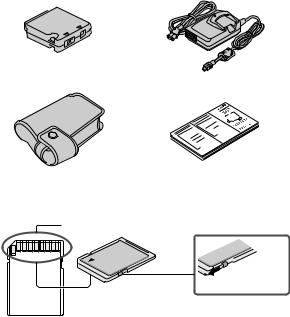
i Cable adaptor: 1 |
i AC adaptor/charger and |
|
power cord: 1 |
i Soft case: 1 |
i Quick guide |
i SD Memory Card: 1
An SD Memory Card may not be an included accessory, depending on the region in which the camera is sold. If this is the case, please purchase a commercially sold memory card.
Contact end |
Lock switch |

 Lock
Lock
Unlock
hRecording (images and sounds) and erasing are inhibited (accidental erase protect function) when the lock switch is set to the LOCK
position.
hThe card is normally used with the lock switch set to the unlocked position.
English 26
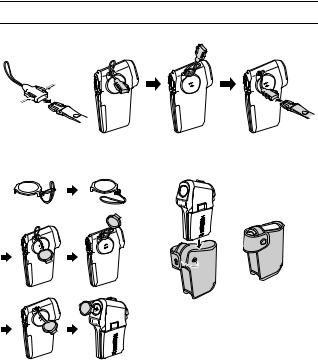
CHECKING THE INCLUDED ACCESSORIES
k Neckstrap
k Lens cap |
k Soft case |
27 English
